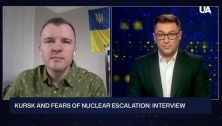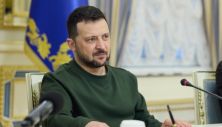One of the most intense bombardments against Ukraine since the beginning of the Russian invasion took place on August 27. The Russian attack on Kiev...
Vous n'êtes pas connecté
- English
- Français
- عربي
- Español
- Deutsch
- Português
- русский язык
- Català
- Italiano
- Nederlands, Vlaams
- Norsk
- فارسی
- বাংলা
- اردو
- Azərbaycan dili
- Bahasa Indonesia
- Հայերեն
- Ελληνικά
- Bosanski jezik
- українська мова
- Íslenska
- Türkmen, Түркмен
- Türkçe
- Shqip
- Eesti keel
- magyar
- Қазақ тілі
- Kalaallisut ; kalaallit oqaasii
- Lietuvių kalba
- Latviešu valoda
- македонски јазик
- Монгол
- Bahasa Melayu ; بهاس ملايو
- ဗမာစာ
- Slovenščina
- тоҷикӣ ; toğikī ; تاجیکی
- ไทย
- O'zbek ; Ўзбек ; أۇزبېك
- Tiếng Việt
- ភាសាខ្មែរ
- རྫོང་ཁ
- Soomaaliga ; af Soomaali
Rubriques :
 Maroc - EURASIAREVIEW.COM - A la une - 06/Aug 22:19
Maroc - EURASIAREVIEW.COM - A la une - 06/Aug 22:19
Ukraine And The Frontlines Of The War On Disinformation – Analysis
By Kollen Post (FPRI) -- On July 8, a Russian Kh-101 rocket flew into a children’s hospital in the center of Kyiv. On July 9, no less a figure than Dmitry Peskov, the Kremlin’s primary mouthpiece, took toTASS,a preferred Kremlin megaphone, to declare “as before, we maintain: We do not strike civilian objects.” Almost immediately, Kremlin-affiliated Telegramchannelsand pro-Russianpropagandistson Twitter took to blaming the attack on Ukraine’s air defense, specifically first a US-supplied Patriot missile, before settling on a NATO-supplied NASAMS missile—belying the jet engine visible in footage of the strike and setting up one of the most insulting narratives of victim-blaming imaginable. The fake news campaigns over Ukraine have become relentless in the West but are endemic within Ukraine itself. Some preferred themes include misfortune befalling Kyiv’s Chief of Defense Intelligence Budanov, President Zelensky abandoning the country for some estate in the UK or a private island, or egregious corruption in the Ukrainian government with Zelensky’s right-hand man, Andriy Yermak, a frequent target. Many recurrent subjects for fake news fodder—like Budanov’s death—are overtly false. Though they are easily falsifiable, they are also easily verifiable. But others are trickier. One of the biggest ongoing campaigns concerns mobilization. Specifically, social media is awash in videos of Ukrainian soldiers and police violently pulling men off the streets. These types of campaigns are impossible to disprove. Some may be authentic—but their virality can be suspicious. Genuine videos, like true news that fits specific narratives, can get picked up by coordinated behavior on social media. In the case of the threat of mobilization or corruption, the propagation of specific instances shrouds Ukraine in paranoia—unpredictable missiles above, unprovable conspiracies below. It is an informational war for hearts and minds. In the West, this can result in a distressing corrosion of faith in cherished institutions. But in Ukraine, hearts and minds translate directly into blood and land in a kinetic war. The Western Defense The entire world has been forced to confront the threat of disinformation as social media has emerged over the past decade and a half as a serious source of information for billions of users. Featuring the surprise votes for Brexit and the election of Donald Trump, tinged as they were with suspicions of Russian-backed social media meddling, 2016 brought the term “disinformation” into the English-language mainstream for the first time. The West has radically reconfigured its relationship to media and information in the intervening eight years. Silicon Valley’s social media giants—darlings throughout the Obama years—have yet to leave the doghouse 2016 put them into. Government interest in the information war surged. The Obama Department of State launched a Center for Strategic Counterterrorism Communications in 2011. It was, in 2016, rebranded into the Global Engagement Center—initially aiming to stave off jihadist recruitment but eventuallysettlingon the mission statement of “contesting the information battlespace.” In many ways, the amorphous, ever-present, and era-defining threat of terrorism was quietly swapped out for disinformation around exactly this timeframe. A whole cottage industry of freshly minted disinformation specialists cropped up. Maybe the most famous is Nina Jankowicz, whose brief tenure in 2022 as the head of the Biden administration’s “Disinformation Governance Board” came to an end as congressional Republicans took umbrage at the office’s focus on stamping out conservative narratives. It is no surprise that many of the scions of the American disinformation apparatus come out of Eastern European or Soviet studies. Jankowicz, for example, was a Fulbright fellow in Kyiv, where she worked on counter-disinformation campaigns. The USSR and USA were locked in an information war long before social media put that war into the hands of every smartphone owner on the planet. Caged with the Bear Ukraine was, in many ways, ground zero. The country has been bound up with Russia’s information space since the dawn of publication. The legacy of Ivan Fyodorov, who—in the 16th century—set up the first Russian printing press in St. Petersburg before moving to Lviv and building the first on the modern territory of Ukraine, remains ground for a cultural war between the two countries. Fyodorov’s ambiguous origins complicate matters — indeed, for those who consider him Ukrainian, his name is Fedorov, a somewhat poetic dispute over a typesetter’s spelling. Long before full-scale war, the conflict between Russia and Ukraine centered around the Russian refrain that Ukrainians are the same people, wrongly partitioned by Western interlopers. Unlike, for example, Poland, Ukrainians as far back as the Tsarist times were formally considered “little Russians”—as long as they did not try to write anything down in Ukrainian. It was a trend aided by the import of ethnic Russians into major cities. Many Ukrainians bought into it. Linguistic and cultural ties mean that Ukraine has long been a testbed for Russian and Soviet propaganda. Sometimes that has meant vulnerability. But despite having fewer resources than the US or EU, many Ukrainians have a long-standing familiarity with and inoculation against the virality of Russian propaganda. That does not mean the disease is gone. The Treatments What that familiarity translates to is an active, internal fight that picked up in earnest after 2014—a harbinger for what would hit the West two years later. The Kremlin has long fostered a brood of state-owned news outlets, likeTASS,RIA Novosti, andRussia Today, which are banned throughout Ukraine. But the Euromaidan was, alongside the Arab Spring that kicked off slightly earlier, a largely social-media-driven protest movement. Russia would learn its lesson: Social media is the primary battleground for information today. It is no surprise that the first major discoveries of Russian bot farms date from this period. Perhaps the most notorious is the Internet Research Agency. The US Treasurysanctionedthe now-infamous bot farm in March 2018, introducing many to the name Yevgeny Prigozhin for the first time. Despite those sanctions and Prigozhin’s death last summer in a plane crash almost certainly ordered by President Putin, Prigozhin’s troll farmsreportedlylive on. Bot farms physically based in Russia are difficult to identify and almost impossible to fully squelch. Oftentimes, the social media platforms themselves are the only entities with the necessary metadata to do so. Nevertheless, Ukrainian security services frequentlyannouncethe bust-up of bot farms aiming at social media influence on Ukrainian territory. This is, however, a game of whack-a-mole. It requires far more resources to track down and break up a bot farm than it does to set up a new one. Many bot farms were often indistinguishable from content mills full of underemployed and underpaid Eastern European writers. In the era of AI, it has gotten evencheaperto pump out unoriginal news content slanted in whichever direction. Other official offices preemptively spotlight Russian narratives scuttling across the web. In March of 2021, the National Security and Defense Council of Ukraine launched the Center for Countering Disinformation, an office that highlights “fakes.” For example, the center recentlypostedthat Natalie Morris of American podcast Redacted was spreading disinformation that suggested Ukraine was responsible for the July 8 missile strike on the children’s hospital in Kyiv. It’s not a new idea. As far back as 2014, the NGO Media Reforms Center launched “StopFake,” performing a similar service with the backing of several Western governments. They have similarly beenactiveon the July 8 missile strike and compared it to Russian informationcampaignsdating back to air strikes in Syria. A commonality across Ukraine’s anti-disinformation offices is that they almost exclusively aim at information that is negative for the Ukrainian government. Such information often—but certainly not always—originates from Russian campaigns. The Ukrainian government is fallible and frequently scapegoats Russia when unflattering news comes to light. Over the winter, news spread of growing conflict between Volodymyr Zelensky and Valery Zaluzhny, the hugely popular head of Ukraine’s armed forces at the time. In December, the Center for Countering of Disinformation released avideocalling these reports Russian-made fakes. Zaluzhny was officiallyoutin early February. Prognosis In the same way that terror was a real threat but the war on terror became a tool of surveillance, disinformation is a real threat but many of the weapons in the war on disinformation are indistinguishable from censorship. Maybe the most radical solution to disinformation within Ukraine is a bill currently before the Rada, Ukraine’s parliament, that would ban Telegram, a high-profile platform for information sharing. That bill is unlikely to pass, and a ban would almost certainly fail—indeed, Russia passed such a bill and, despite having a much stronger internet censorship apparatus than Ukraine’s, its effect was comically ineffectual. Several Russian parliamentarians were photographed continuing to use the banned app on the Duma floor. This bill also passively neglects just how much information warfare proliferates across YouTube and Facebook and will continue to proliferate in whatever open platforms remain accessible after shutting others down. Perhaps the most effective intervention against true Russian propaganda has been incidental. Ukraine has, by and large, successfully excised the Russian language from public life since the start of the full-scale invasion. A commonality 10 years ago, seeing a national political or media figure make a pronouncement in Russian is unimaginable today. On the TV channel Kvartal, centered on programming from production studio Kvartal 95, which Zelensky founded and which in turn made him a star, reruns of shows featuring the now-president speaking Russian are now broadcast in Ukrainian dubs. The siloing off of the Russian language promises to allow the development of a truly independent Ukrainian information space. That is a slow process at the best of times—the flagship news brands in the English language tout pedigrees going back centuries. As war ravages the economy, there’s not a surplus of money going to media. But beyond limited resources amid wartime, the Ukrainian government has proved hostile to open information—a featurenotedby James Rubin, who runs the US State Department’s Global Engagement Center. Perhaps the most notable example of fudging bad news from the battlefield is the Ukrainian government’s refusal to state a death count for Ukrainian soldiers. That ended in February when Zelenskysaidthat number was 31,000, while for Russia it was 180,000. No independent observer considers either number accurate, but actual challenges to them, especially the number of Ukrainian soldiers dead, have been minimal. Nobody applies the word “disinformation” to that number. Many Ukrainians, including those in the media, see challenges to government pronouncements as on some level inherently treasonous. Indeed, the Rada managed to keep journalists out of its halls until May and remains stingy with permissions. Two Ukrainian outlets driving local investigations foundthemselvestargeted by governmental intimidation and blackmail campaigns last year. Reporting from the Kyiv Independentnotedthe Ukrainian military using the draft as a weapon of retribution against wayward journalists. Beyond the ethical ramifications, the problem with stamping out negative reports is that Ukrainians, while publicly proclaiming glory to the heroes and glory to the armed forces, know that their institutions are imperfect. In the search for critical information about their society and leaders, they remain dependent on unofficial and often anonymous or unvetted sources of information. In addition to linguistic independence, the most important intervention against disinformation within Ukraine would be the rise of a rich, diligent, and combative local media ecosystem. At the moment, there’s precious little of that to be found, and the Ukrainian government is inclined to weeding it out where it finds it. Despite gestures to the contrary, the core of the Ukrainian government retains a relationship to the press that remains arch and, in many ways the dirtiest of words in Kyiv today, Soviet. That entails tightly controlling zones of access, dictating narrative, and passively viewing journalism as the intersection of PR and espionage. The hype cycle of the first year and a half of the war indeed may have exacerbated the problem, establishing an expectation of journalism rightly called fawning. That relationship between government and press requires a complete overhaul. That should start with follow-through on investigations into the persecution of journalists, continue with a cessation ofweaponizingthe Ukraine Ministry of Defense’s accreditation process, and ultimately lead to an expectation of officials answering basic questions of who, what, when, where, and why. Anti-disinformation campaigns are a late-stage intervention. However, an ounce of prevention is worth a pound of cure. The real elixir for disinformation is a freer flow of information at the outset. Some may consider such a transformation unpragmatic during wartime, but Ukraine has promoted its war relentlessly as one of rule of law and freedom against oligarchy and tyranny. In a war based on such principles, it is unacceptable to allow truth to be the first casualty. About the author: Kollen Post is a freelance journalist, photographer, and interpreter. Based in Kyiv, he specializes in Ukrainian civil society, technology, and human stories within the war. Source: This article was published by FPRI
Articles similaires
Putin From Kursk To Kursk – OpEd
By Georgi Gotev (EurActiv) -- When Ukraine launched its incursion into Russian territory in the Kursk Oblast on 6 August, many Western analysts...
Putin From Kursk To Kursk – OpEd
By Georgi Gotev (EurActiv) -- When Ukraine launched its incursion into Russian territory in the Kursk Oblast on 6 August, many Western analysts...
For Putin, War In Ukraine Is A Means Not An End In Itself – OpEd
Vladimir Putin’s war in Ukraine is “a means” to broader ends rather than “a goal in itself,” Dmitry Shusharin says. Indeed, as far as he...
The Regime’s Wars Are Built On Lies – OpEd
By Karen Kwiatkowski Americans are increasingly uneasy about their “national” security, and increasingly concerned that war is lapping at our...
The Regime’s Wars Are Built On Lies – OpEd
By Karen Kwiatkowski Americans are increasingly uneasy about their “national” security, and increasingly concerned that war is lapping at our...
Kursk and fears of nuclear escalation. Interview with Jake Broe
What is the impact of Kursk operation? Is there any risk of nuclear escalation? Why hasn't Putin been defeated yet? Why aren't there more weapons...
Kursk operation: Zelenskyy explains how long Ukraine will keep Russian territory under its control
President Volodymyr Zelenskyy said that Ukraine will keep part of the Kursk region under its control as part of the plan to win the war. He said...
Ukraine is not asking for anything more than what your country or any other country already has – speech by the Zelenskyy at the 50th Ambrosetti International Forum
Good evening, Italy! And thank you for supporting our country and our people. We appreciate every step in support of Ukraine – every action and...
Ukraine is not asking for anything more than what your country or any other country already has – speech by the Zelenskyy at the 50th Ambrosetti International Forum
Good evening, Italy! And thank you for supporting our country and our people. We appreciate every step in support of Ukraine – every action and...
Les derniers communiqués
-
Adobe Brings Conversational AI to Trillions of PDFs with the New AI Assistant in Reader and Acrobat
Adobe - 21/02/2024
-
Laura Frigenti takes the Helm as Chief Executive Officer of the Global Partnership for Education
Global Partnership for Education - 05/12/2022


